注解
此笔记本可在此处下载: 1_ML_Tutorial_SVM.ipynb
1-支持向量机
from IPython.display import IFrame
IFrame('https://mljs.github.io/libsvm/#/SVC', width=800, height=800)
# Load the dataset
from keras.datasets import mnist
(x_train, y_train), (x_test, y_test) = mnist.load_data()
Using TensorFlow backend.
# Scale images from [0,255] to [0,1]
x_train_normalized = x_train / 255.0
import matplotlib
import matplotlib.pyplot as plt
%matplotlib inline
# %matplotlib nbagg
# %matplotlib ipympl
# %matplotlib notebook
import numpy as np
# Sample a smaller dataset for testing
rand_idx = np.random.choice(x_train.shape[0], 10000)
x_train = x_train_normalized[rand_idx]
y_train = y_train[rand_idx]
print('** What is the shape of your dataset? **')
(10000, 28, 28)
# Support Vector Machine
from sklearn import svm, metrics
# Create a Support Vector Classifier with the Defaults Scikit-Learn hyperparameters
clf = '** Add your code here **'
print('We have create an SVM Classifier with parameters:')
print(clf)
We have create an SVM Classifier with parameters:
SVC(C=1.0, cache_size=200, class_weight=None, coef0=0.0,
decision_function_shape='ovr', degree=3, gamma=0.001, kernel='rbf',
max_iter=-1, probability=False, random_state=None, shrinking=True,
tol=0.001, verbose=False)
%time clf.fit(x_train.reshape(-1, 28 * 28), y_train)
CPU times: user 34.5 s, sys: 139 ms, total: 34.6 s
Wall time: 34.8 s
SVC(C=1.0, cache_size=200, class_weight=None, coef0=0.0,
decision_function_shape='ovr', degree=3, gamma=0.001, kernel='rbf',
max_iter=-1, probability=False, random_state=None, shrinking=True,
tol=0.001, verbose=False)
# Validate the model performance: predict the classified digit from the test dataset
%time y_predicted = clf.predict(x_test.reshape(-1, 28 * 28))
CPU times: user 43.7 s, sys: 185 ms, total: 43.9 s
Wall time: 44.7 s
# What we should have predicted:
y_test
array([7, 2, 1, ..., 4, 5, 6], dtype=uint8)
# What we have predicted with our model:
y_predicted
array([2, 2, 2, ..., 2, 2, 2], dtype=uint8)
print("Classification report for classifier %s:\n%s\n" % (clf, metrics.classification_report(y_test, y_predicted)))
cm = metrics.confusion_matrix(y_test, y_predicted)
print("Confusion matrix:\n%s" % cm)
print("Accuracy={}".format(metrics.accuracy_score(y_test, y_predicted)))
Classification report for classifier SVC(C=1.0, cache_size=200, class_weight=None, coef0=0.0,
decision_function_shape='ovr', degree=3, gamma=0.001, kernel='rbf',
max_iter=-1, probability=False, random_state=None, shrinking=True,
tol=0.001, verbose=False):
precision recall f1-score support
0 0.00 0.00 0.00 980
1 0.00 0.00 0.00 1135
2 0.10 1.00 0.19 1032
3 0.00 0.00 0.00 1010
4 0.00 0.00 0.00 982
5 0.00 0.00 0.00 892
6 0.00 0.00 0.00 958
7 0.00 0.00 0.00 1028
8 0.00 0.00 0.00 974
9 0.00 0.00 0.00 1009
micro avg 0.10 0.10 0.10 10000
macro avg 0.01 0.10 0.02 10000
weighted avg 0.01 0.10 0.02 10000
Confusion matrix:
[[ 0 0 980 0 0 0 0 0 0 0]
[ 0 0 1135 0 0 0 0 0 0 0]
[ 0 0 1032 0 0 0 0 0 0 0]
[ 0 0 1010 0 0 0 0 0 0 0]
[ 0 0 982 0 0 0 0 0 0 0]
[ 0 0 892 0 0 0 0 0 0 0]
[ 0 0 958 0 0 0 0 0 0 0]
[ 0 0 1028 0 0 0 0 0 0 0]
[ 0 0 974 0 0 0 0 0 0 0]
[ 0 0 1009 0 0 0 0 0 0 0]]
Accuracy=0.1032
/Users/Pierre/.virtualenvs/DeepQC/lib/python3.6/site-packages/sklearn/metrics/classification.py:1143: UndefinedMetricWarning: Precision and F-score are ill-defined and being set to 0.0 in labels with no predicted samples.
'precision', 'predicted', average, warn_for)
#Plots confusion matrix
def plot_confusion_matrix(cm, title='Confusion matrix'):
plt.figure(1, figsize=(15, 12), dpi=160)
plt.imshow(cm, interpolation='nearest', cmap=plt.cm.Blues)
plt.title(title)
plt.colorbar()
plt.tight_layout()
plt.ylabel('True label')
plt.xlabel('Predicted label')
plt.show()
plot_confusion_matrix(cm)
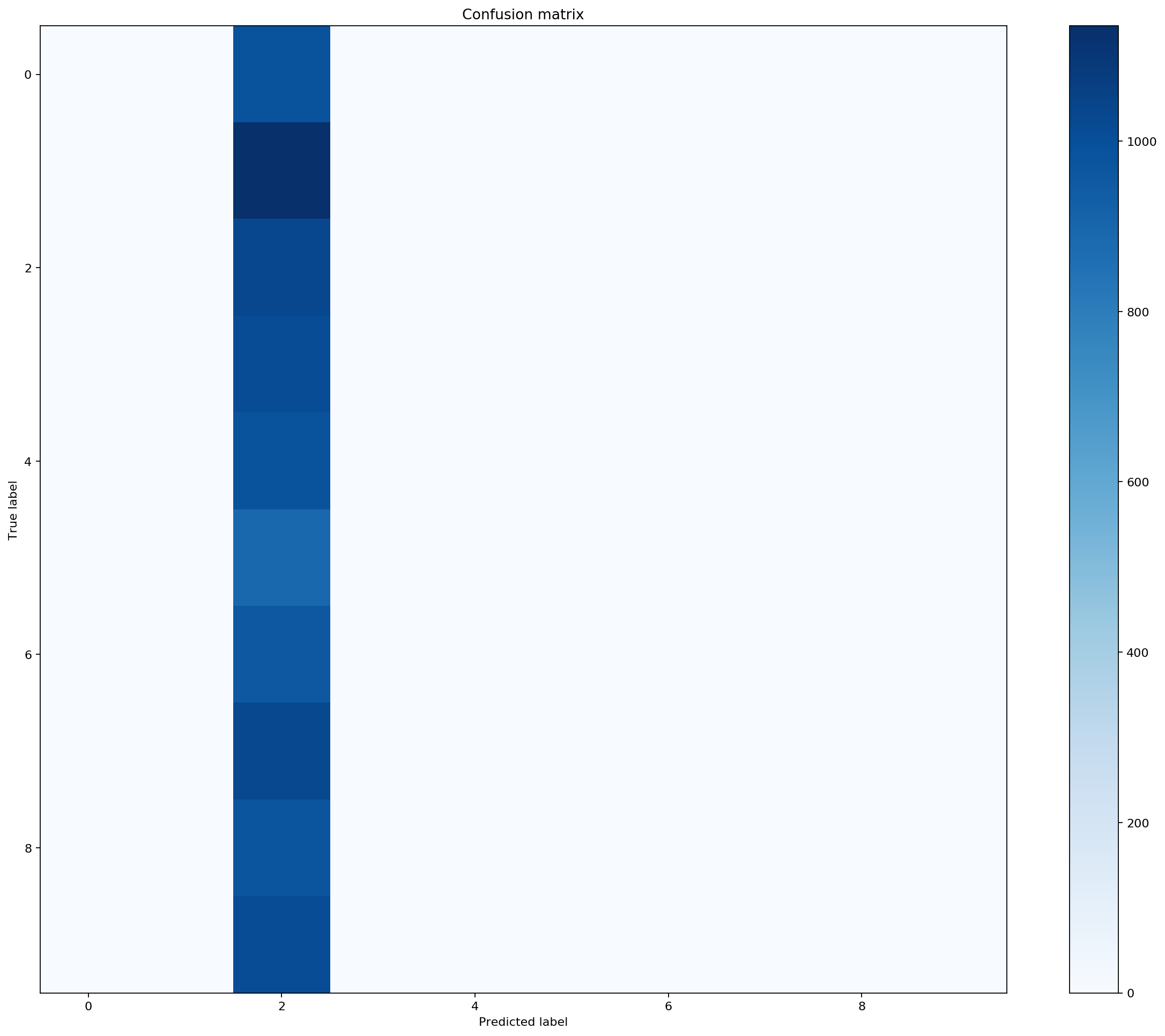
2-超参数调整:更好更快地分类
# Hyperparameters tuning: better and faster
clf_faster = '** Add your code here **' # Faster with linear kernel + handtuned C and gamma
print('We have create a faster SVM Classifier with parameters:')
print(clf_faster)
We have create a faster SVM Classifier with parameters:
SVC(C=5, cache_size=200, class_weight=None, coef0=0.0,
decision_function_shape='ovr', degree=3, gamma=0.05, kernel='linear',
max_iter=-1, probability=False, random_state=None, shrinking=True,
tol=0.001, verbose=False)
%time clf_faster.fit(x_train.reshape(-1, 28 * 28), y_train)
CPU times: user 12.1 s, sys: 58.9 ms, total: 12.2 s
Wall time: 12.5 s
SVC(C=5, cache_size=200, class_weight=None, coef0=0.0,
decision_function_shape='ovr', degree=3, gamma=0.05, kernel='linear',
max_iter=-1, probability=False, random_state=None, shrinking=True,
tol=0.001, verbose=False)
# Validate the model performance: predict the classified digit from the test dataset
%time y_predicted = clf_faster.predict(x_test.reshape(-1, 28 * 28))
y_predicted
CPU times: user 20.1 s, sys: 81.2 ms, total: 20.2 s
Wall time: 20.8 s
array([3, 2, 1, ..., 4, 8, 6], dtype=uint8)
print("Classification report for classifier %s:\n%s\n" % (clf_faster, metrics.classification_report(y_test, y_predicted)))
cm = metrics.confusion_matrix(y_test, y_predicted)
print("Confusion matrix:\n%s" % cm)
print("Accuracy={}".format(metrics.accuracy_score(y_test, y_predicted)))
plot_confusion_matrix(cm, title='Tuned SVM Confusion Matrix')
Classification report for classifier SVC(C=5, cache_size=200, class_weight=None, coef0=0.0,
decision_function_shape='ovr', degree=3, gamma=0.05, kernel='linear',
max_iter=-1, probability=False, random_state=None, shrinking=True,
tol=0.001, verbose=False):
precision recall f1-score support
0 0.87 0.98 0.92 980
1 0.97 0.83 0.90 1135
2 0.93 0.79 0.85 1032
3 0.79 0.82 0.81 1010
4 0.86 0.96 0.91 982
5 1.00 0.26 0.42 892
6 0.90 0.94 0.92 958
7 0.98 0.79 0.88 1028
8 0.52 0.97 0.68 974
9 0.86 0.86 0.86 1009
micro avg 0.83 0.83 0.83 10000
macro avg 0.87 0.82 0.81 10000
weighted avg 0.87 0.83 0.82 10000
Confusion matrix:
[[962 0 1 3 1 0 8 0 5 0]
[ 0 946 3 4 0 0 4 1 177 0]
[ 19 15 817 25 12 0 38 2 100 4]
[ 8 0 7 832 0 0 4 3 153 3]
[ 1 0 3 1 940 0 13 1 6 17]
[ 81 2 9 138 38 234 28 2 345 15]
[ 11 1 11 5 6 1 905 0 18 0]
[ 7 7 25 18 27 0 0 814 31 99]
[ 8 0 1 11 5 0 3 1 944 1]
[ 5 5 5 17 63 0 0 5 43 866]]
Accuracy=0.826
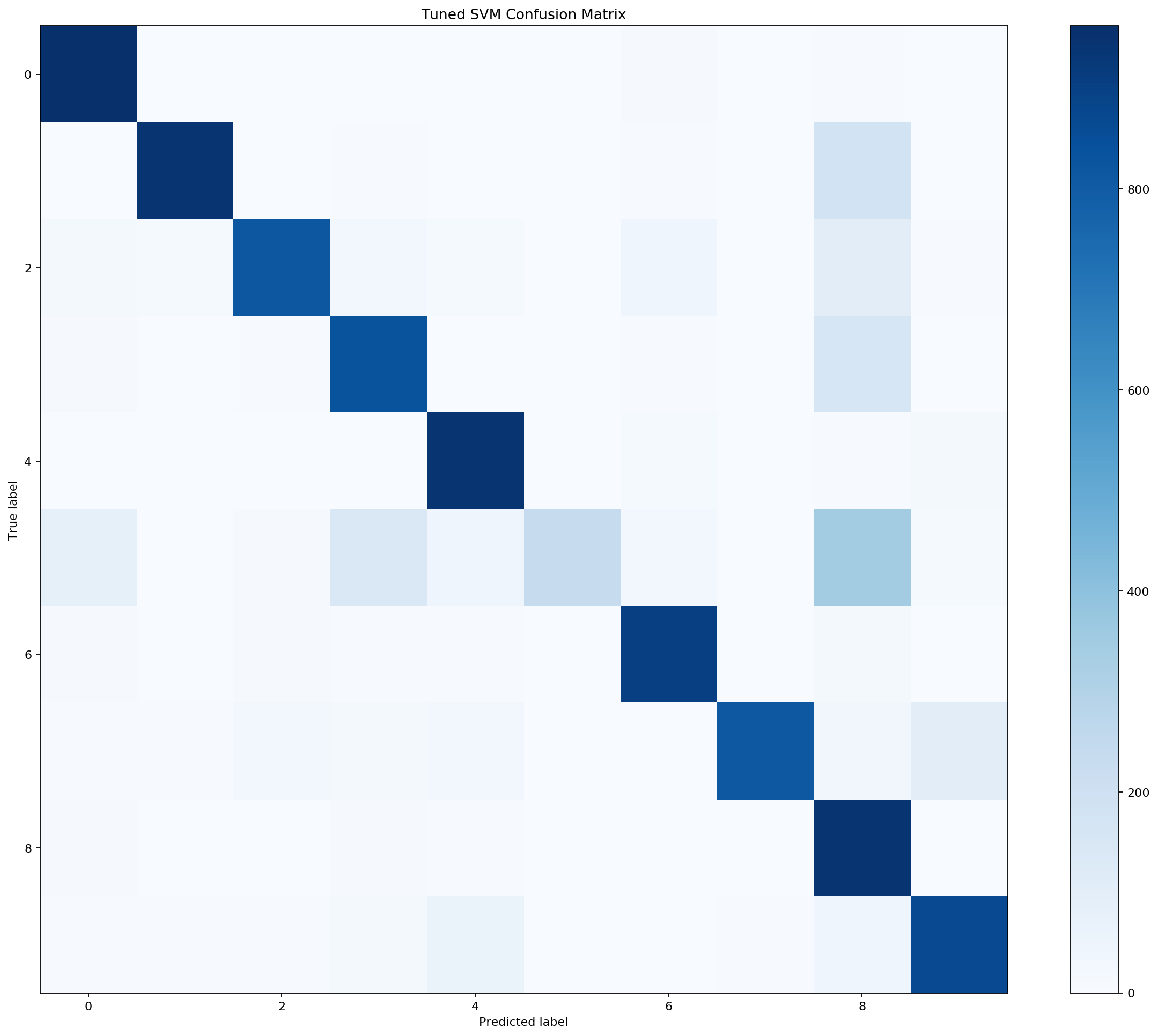
3-信息简化:主成分分析
在运行代价高昂的分类器之前,我们可以从输入数据中提取最少的所需信息吗?
from sklearn.decomposition import PCA
# Let's embedded 28 * 28 = 784 pixels as only 2 dimensions:
pca_2D = '** Add your code here **'
x_train_2D = pca_2D.transform(x_train.reshape(-1, 28 * 28))
x_train_2D.shape
(10000, 2)
pca_2D.explained_variance_ratio_
array([0.09665204, 0.06986566])
plt.scatter(x_train_2D[:, 0], x_train_2D[:, 1], c=y_train[:], edgecolor='none', alpha=0.5,
cmap=plt.get_cmap('jet', 10), s=5)
plt.colorbar()
<matplotlib.colorbar.Colorbar at 0x10427ca58>
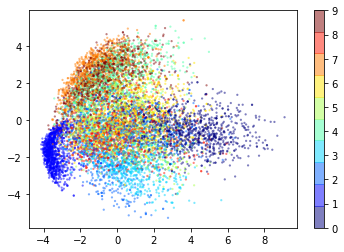
# Embedded images in 10 dimensions:
pca_10D = '** Add your code here **'.fit(x_train.reshape(-1, 28 * 28))
pca_10D
PCA(copy=True, iterated_power='auto', n_components=10, random_state=None,
svd_solver='auto', tol=0.0, whiten=False)
pca_10D.explained_variance_ratio_
array([0.09665204, 0.06986566, 0.06246802, 0.05519677, 0.04828766,
0.04332001, 0.03256506, 0.0292913 , 0.02727743, 0.02342807])
sum(pca_10D.explained_variance_ratio_)
0.48835202138877953
plt.plot(np.cumsum(pca_10D.explained_variance_ratio_))
plt.xlabel('# of components')
plt.ylabel('Cumulative explained variance')
Text(0, 0.5, 'Cumulative explained variance')
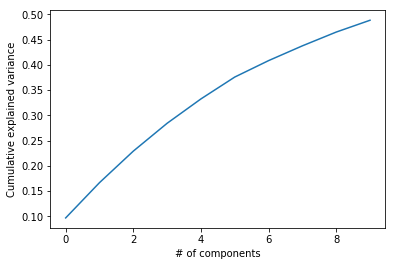
x_train_reduced = pca_10D.transform(x_train.reshape(-1, 28 * 28))
print('What is the dimension of X_train_reduced?')
(10000, 10)
%time clf_faster.fit(x_train_reduced, y_train)
CPU times: user 2.67 s, sys: 15.6 ms, total: 2.69 s
Wall time: 2.69 s
SVC(C=5, cache_size=200, class_weight=None, coef0=0.0,
decision_function_shape='ovr', degree=3, gamma=0.05, kernel='linear',
max_iter=-1, probability=False, random_state=None, shrinking=True,
tol=0.001, verbose=False)
# Validate the model performance: predict the classified digit from the test dataset
%time y_predicted = clf_faster.predict(pca_10D.transform(x_test.reshape(-1, 28 * 28)))
y_predicted
CPU times: user 973 ms, sys: 88.6 ms, total: 1.06 s
Wall time: 675 ms
array([7, 3, 1, ..., 4, 8, 6], dtype=uint8)
print("Classification report for classifier %s:\n%s\n" % (clf_faster, metrics.classification_report(y_test, y_predicted)))
cm = metrics.confusion_matrix(y_test, y_predicted)
print("Confusion matrix:\n%s" % cm)
print("Accuracy={}".format(metrics.accuracy_score(y_test, y_predicted)))
plot_confusion_matrix(cm, title='PCA(10) then LinearSVM Confusion Matrix')
Classification report for classifier SVC(C=5, cache_size=200, class_weight=None, coef0=0.0,
decision_function_shape='ovr', degree=3, gamma=0.05, kernel='linear',
max_iter=-1, probability=False, random_state=None, shrinking=True,
tol=0.001, verbose=False):
precision recall f1-score support
0 0.71 0.96 0.82 980
1 0.99 0.74 0.84 1135
2 0.83 0.80 0.81 1032
3 0.75 0.74 0.75 1010
4 0.80 0.61 0.69 982
5 0.88 0.02 0.05 892
6 0.89 0.85 0.87 958
7 0.96 0.71 0.82 1028
8 0.36 0.95 0.52 974
9 0.61 0.49 0.54 1009
micro avg 0.69 0.69 0.69 10000
macro avg 0.78 0.69 0.67 10000
weighted avg 0.78 0.69 0.68 10000
Confusion matrix:
[[942 0 5 4 0 0 5 0 23 1]
[ 0 837 12 3 0 0 6 0 277 0]
[ 39 0 826 11 16 0 34 4 102 0]
[ 36 2 12 751 0 2 2 4 199 2]
[ 5 1 15 7 597 0 32 2 108 215]
[195 2 17 151 8 22 13 1 465 18]
[ 46 5 51 1 6 0 812 0 37 0]
[ 25 0 43 33 3 1 0 730 119 74]
[ 10 0 6 15 4 0 4 2 929 4]
[ 22 0 14 30 108 0 3 16 322 494]]
Accuracy=0.694
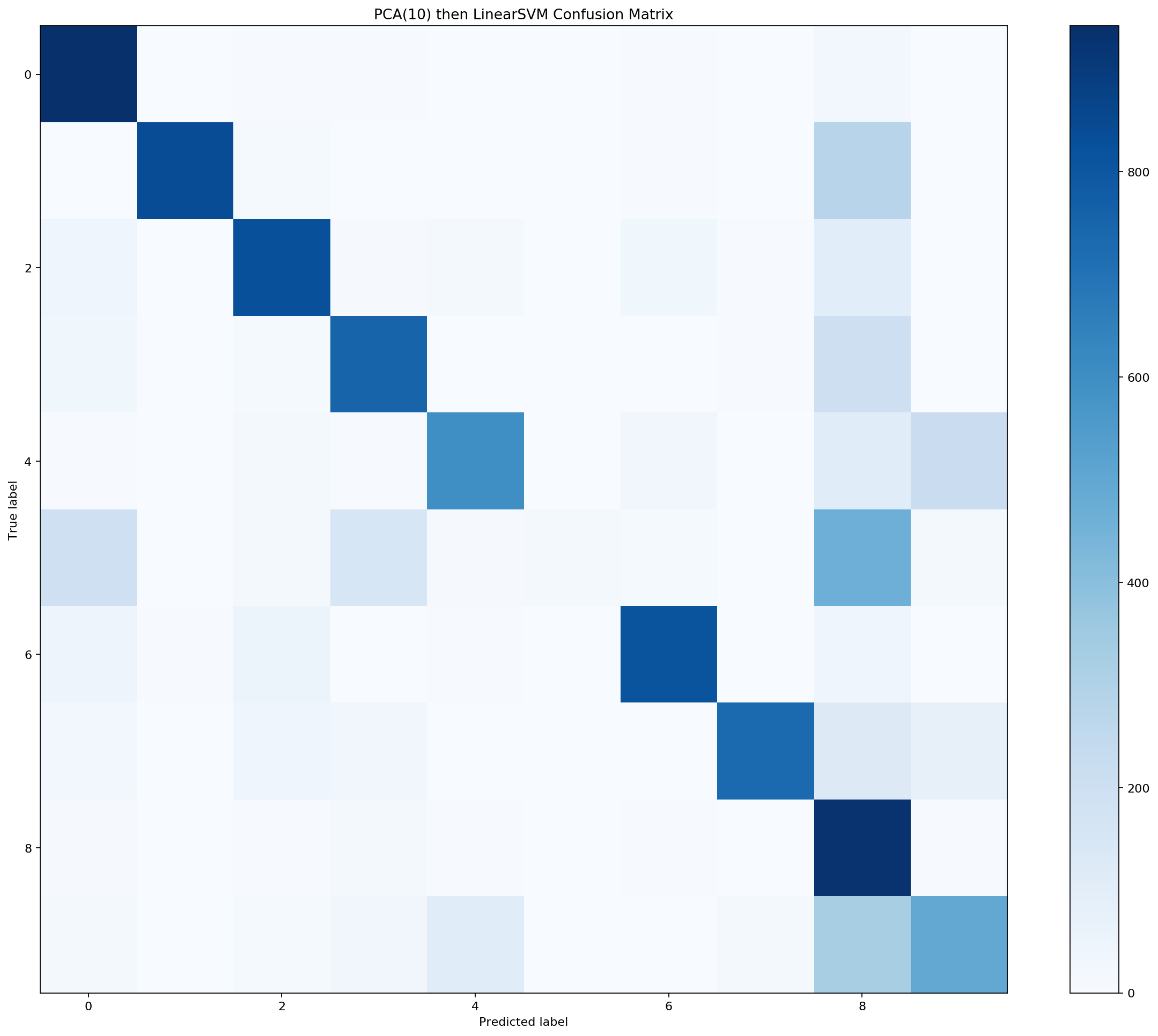
4-高级超参数调整:网格搜索
from sklearn.model_selection import GridSearchCV
# We test multiple Gamma and C values:
# gamma_range = np.outer(np.logspace(-3, 0, 4),np.array([1,5])).flatten()
gamma_range = np.outer(np.logspace(-3, 1, 3),np.array([1])).flatten()
gamma_range
array([1.e-03, 1.e-01, 1.e+01])
# We will test on multiple C parameters:
# C_range = np.outer(np.logspace(-3, 3, 7),np.array([1,2, 5]))
# C_range = np.outer(np.logspace(-1, 1, 3), np.array([1, 5])).flatten()
C_range = np.outer(np.logspace(-3, -1, 3), np.array([1])).flatten()
C_range
array([0.001, 0.01 , 0.1 ])
parameters = {'kernel':['linear'], 'C': C_range, 'gamma': gamma_range}
svm_clf = svm.SVC()
grid_clf = '** Add your code here **'
grid_clf
GridSearchCV(cv='warn', error_score='raise-deprecating',
estimator=SVC(C=1.0, cache_size=200, class_weight=None, coef0=0.0,
decision_function_shape='ovr', degree=3, gamma='auto_deprecated',
kernel='rbf', max_iter=-1, probability=False, random_state=None,
shrinking=True, tol=0.001, verbose=False),
fit_params=None, iid='warn', n_jobs=4,
param_grid={'kernel': ['linear'], 'C': array([0.001, 0.01 , 0.1 ]), 'gamma': array([1.e-03, 1.e-01, 1.e+01])},
pre_dispatch='2*n_jobs', refit=True, return_train_score='warn',
scoring=None, verbose=2)
%time grid_clf.fit(x_train_small.reshape(-1, 28 * 28), y_train_small)
best_clf = grid_clf.best_estimator_
print('Best hyperparameters founded are:')
grid_clf.best_params_
y_predicted = best_clf.predict(x_test.reshape(-1, 28 * 28))
scores = grid_clf.cv_results_['mean_test_score'].reshape(len(C_range),
len(gamma_range))
scores
def plot_param_space_heatmap(scores, C_range, gamma_range):
"""https://github.com/ksopyla/svm_mnist_digit_classification/blob/master/mnist_helpers.py#L52"""
plt.figure(figsize=(8, 6))
plt.subplots_adjust(left=.2, right=0.95, bottom=0.15, top=0.95)
plt.imshow(scores, interpolation='nearest', cmap=plt.cm.jet)
plt.xlabel('gamma')
plt.ylabel('C')
plt.colorbar()
plt.xticks(np.arange(len(gamma_range)), gamma_range, rotation=45)
plt.yticks(np.arange(len(C_range)), C_range)
plt.title('Validation accuracy')
plt.show()
plot_param_space_heatmap(scores, C_range, gamma_range)
# Even easier: TPOT
# https://github.com/EpistasisLab/tpot
from tpot import TPOTClassifier
tpot = TPOTClassifier(generations=5, population_size=50, verbosity=2)
tpot.fit(x_train.reshape(-1, 28 * 28), y_train)
print(tpot.score(x_test.reshape(-1, 28 * 28), y_test))
5-更多机器学习算法
k-近邻
随机森林
LogisticRegression
XGBoost
聚类
更进一步
In-Depth: Support Vector Machines, from the excellent Jake VanderPlas’ Python Data Science Handbook
Hyperparameters and Model Validation, from the excellent Jake VanderPlas’ Python Data Science Handbook
In-Depth: Principal Component Analysis, from the excellent Jake VanderPlas’ Python Data Science Handbook
资源
https://scikit learn.org/stable/auto_examples/classification/plot_digits_classification.htmlsphx-glr自动示例分类图数字分类py
https://github.com/ksopyla/svm_mnist_digit_classification/blob/master/svm_mnist_classification.py